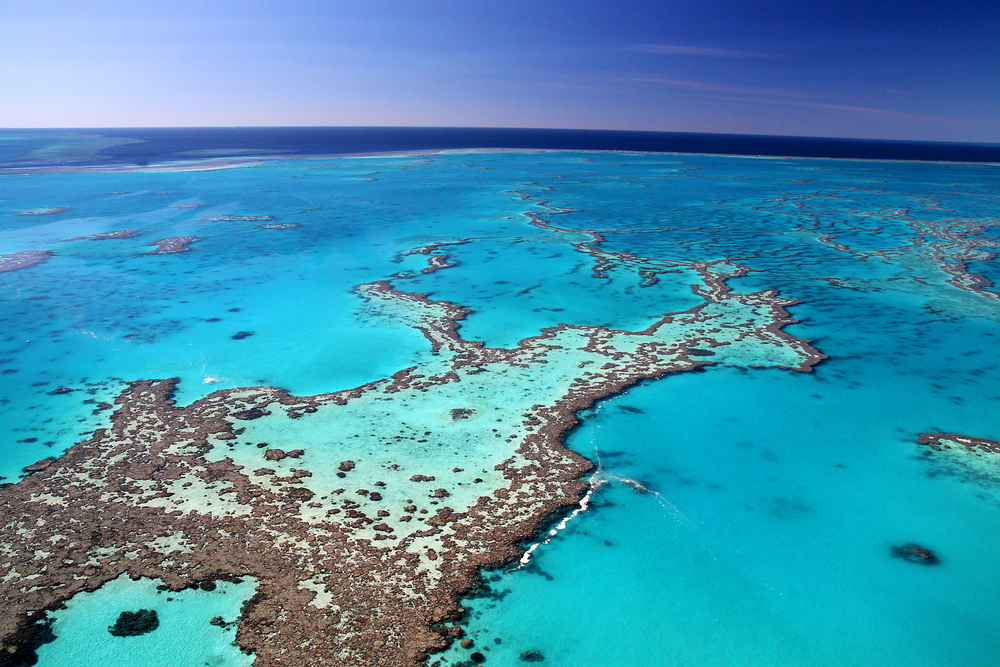The awe-inspiring Great Barrier Reef, situated along Australia’s northeastern shores, is a spectacle to behold. Stretching more than 2,300 kilometers (1,400 miles) and composed of innumerable individual reefs, it holds the title of Earth’s largest coral ecosystem. Join us as we delve into the Great Barrier Reef’s wonders, exploring its magnificent allure, rich variety of lifeforms, and why its conservation is so critical.

Enchanting Splendor:
The Great Barrier Reef is celebrated for its enchanting splendor. Its pristine, azure waters, alive with dynamic coral structures and a plethora of aquatic creatures, create an idyllic haven for divers, snorkeling aficionados, and nature lovers alike. The striking array of hues and complex designs of the reef fabricate an otherworldly marine tableau that enchants visitors.
Remarkable Biodiversity:
A home to a remarkable range of sea dwellers, the Great Barrier Reef boasts an ecosystem bursting with life, housing over 1,500 fish varieties, 600 coral species, and a multitude of other beings, including turtles, dolphins, and sharks. This rich tapestry of biodiversity is ecologically pivotal and plays a key role in maintaining the vitality of the world’s seas.
Crucial Environmental Role:
Far more than just a visually stunning marvel, the Great Barrier Reef serves as a fundamental ecological system. It provides safe haven for a host of marine species, supporting their life cycles through breeding, nourishment, and protection. The sophisticated architecture of the reef defends coastlines from wearing away and damage from storms, while its corals are instrumental in oxygen production and carbon dioxide absorption, hence contributing significantly to climate regulation.
Challenges and Protective Measures:
Regrettably, the Great Barrier Reef is confronted with threats such as global warming, contamination, excessive fishing, and coastal developments. The fragile equilibrium of the reef is jeopardized by escalating sea temperatures and acidifying oceans resulting from climate change. Efforts for conservation are robust, featuring directives for marine parks, initiatives to curb pollution, and scientific inquiries to preserve the reef’s vitality.
Enlightenment Through Tourism:
Annually, the Great Barrier Reef magnetizes multitudes of tourists, providing an invaluable platform for education on marine conservation. It is crucial that tourism adheres to eco-friendly principles, like conscientious diving and snorkeling, to mitigate human impact on the reef. Through interactive programs and escorted explorations, tourists gain insights into and an appreciation for the reef’s ecological value, encouraging caretaking by younger stewards.
World Heritage Recognition:
Due to its unparalleled natural splendor, diversity, and historical importance, the Great Barrier Reef earned its place as a UNESCO World Heritage Site in 1981. This distinction not only exemplifies the reef’s sublimity but also reinforces the duty to safeguard this natural marvel for posterity.
Synergistic Efforts for Conservation:
To effectively conserve the Great Barrier Reef, cooperative initiatives between governments, researchers, conservationists, and local inhabitants are essential. Actions are geared toward diminishing carbon emissions, enhancing water purity, advocating for responsible fishing practices, and enlarging protected aquatic territories. United in purpose, we can assure the continuity and wellbeing of this extraordinary marine system.
The Great Barrier Reef is an emblem of unmatched beauty and crucial ecological importance. Its expansive coral network, striking array of life, and environmental significance render it a symbol of the planet’s stunning natural gifts. As we recognize the perils it faces and commit to its preservation, we can secure the Great Barrier Reef’s legacy for the enjoyment and reverence of generations that follow. Let us pledge to be guardians of this majestic natural ecosystem and collaborate to nurture and safeguard this breathtaking wonder of our world.







